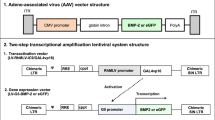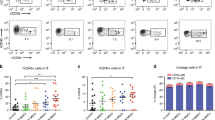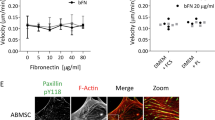Abstract
Human bone marrow-derived mesenchymal stem cells (BM-hMSCs) are nonhematopoietic stem cells that have the potential to differentiate into adipocytes, osteocytes and chondrocytes. Because of its propensity to migrate to the sites of injury and the ability to expand them rapidly, BM-hMSCs have been exploited as potential gene transfer vehicles to deliver therapeutic genes. Herein, we evaluated the feasibility of employing herpes simplex virus type I (HSV-1) amplicon viral vector as a gene delivery vector to BM-hMSCs. High transduction efficiencies were consistently observed in different isolates of BM-hMSCs following infection with HSV-1 amplicon viral vectors. Furthermore, we demonstrated that transduction with HSV-1 amplicon viral vector did not alter the intrinsic properties of the BM-hMSCs. The morphology and cellular proliferation of the transduced BM-hMSCs were not altered. Chromosomal stability, as confirmed by karyotyping and soft agar colony assays, of the transduced BM-hMSCs was not affected. Similarly, transduction with HSV-1 amplicon viral vectors has no effect on the pluripotent differentiation potential and the tumor tropism of BM-hMSCs. Taken together, these results demonstrated that BM-hMSCs could be transduced efficiently by HSV-1 amplicon viral vector in an ‘inert’ manner and thus enable strategies to express potential therapeutic genes in BM-hMSCs.
This is a preview of subscription content, access via your institution
Access options
Subscribe to this journal
Receive 12 print issues and online access
$259.00 per year
only $21.58 per issue
Buy this article
- Purchase on Springer Link
- Instant access to full article PDF
Prices may be subject to local taxes which are calculated during checkout






Similar content being viewed by others
References
Sanchez-Ramos J, Song S, Cardozo-Pelaez F, Hazzi C, Stedeford T, Willing A et al. Adult bone marrow stromal cells differentiate into neural cells in vitro. Exp Neurol 2000; 164: 247–256.
Woodbury D, Schwarz EJ, Prockop DJ, Black IB . Adult rat and human bone marrow stromal cells differentiate into neurons. J Neurosci Res 2000; 61: 364–370.
Deng W, Obrocka M, Fischer I, Prockop DJ . In vitro differentiation of human marrow stromal cells into early progenitors of neural cells by conditions that increase intracellular cyclic AMP. Biochem Biophys Res Commun 2001; 282: 148–152.
Kabos P, Ehtesham M, Kabosova A, Black KL, Yu JS . Generation of neural progenitor cells from whole adult bone marrow. Exp Neurol 2002; 178: 288–293.
Wachs FP, Couillard-Despres S, Engelhardt M, Wilhelm D, Ploetz S, Vroemen M et al. High efficacy of clonal growth and expansion of adult neural stem cells. Lab Invest 2003; 83: 949–962.
Hermann A, Gastl R, Liebau S, Popa MO, Fiedler J, Boehm BO et al. Efficient generation of neural stem cell-like cells from adult human bone marrow stromal cells. J Cell Sci 2004; 117 (Part 19): 4411–4422.
Zhang W, Zeng YS, Zhang XB, Wang JM, Zhang W, Chen SJ . Combination of adenoviral vector-mediated neurotrophin-3 gene transfer and retinoic acid promotes adult bone marrow cells to differentiate into neuronal phenotypes. Neurosci Lett 2006; 408: 98–103.
Mezey E, Chandross KJ, Harta G, Maki RA, McKercher SR . Turning blood into brain: cells bearing neuronal antigens generated in vivo from bone marrow. Science 2000; 290: 1779–1782.
Mezey E, Key S, Vogelsang G, Szalayova I, Lange GD, Crain B . Transplanted bone marrow generates new neurons in human brains. Proc Natl Acad Sci USA 2003; 100: 1364–1369.
Katritsis DG, Sotiropoulou PA, Karvouni E, Karabinos I, Korovesis S, Perez SA et al. Transcoronary transplantation of autologous mesenchymal stem cells and endothelial progenitors into infarcted human myocardium. Catheter Cardiovasc Interv 2005; 65: 321–329.
Perin EC, Dohmann HF, Borojevic R, Silva SA, Sousa AL, Silva GV et al. Improved exercise capacity and ischemia 6 and 12 months after transendocardial injection of autologous bone marrow mononuclear cells for ischemic cardiomyopathy. Circulation 2004; 110 (11 Suppl 1): II213–II218.
Mazzini L, Fagioli F, Boccaletti R, Mareschi K, Oliveri G, Olivieri C et al. Stem cell therapy in amyotrophic lateral sclerosis: a methodological approach in humans. Amyotroph Lateral Scler Other Motor Neuron Disord 2003; 4: 158–161.
Wade-Martins R, Smith ER, Tyminski E, Chiocca EA, Saeki Y . An infectious transfer and expression system for genomic DNA loci in human and mouse cells. Nat Biotechnol 2001; 19: 1067–1070.
Lou J, Xu F, Merkel K, Manske P . Gene therapy: adenovirus-mediated human bone morphogenetic protein-2 gene transfer induces mesenchymal progenitor cell proliferation and differentiation in vitro and bone formation in vivo. J Orthop Res 1999; 17: 43–50.
Conget PA, Minguell JJ . Adenoviral-mediated gene transfer into ex vivo expanded human bone marrow mesenchymal progenitor cells. Exp Hematol 2000; 28: 382–390.
Nakamizo A, Marini F, Amano T, Khan A, Studeny M, Gumin J et al. Human bone marrow-derived mesenchymal stem cells in the treatment of gliomas. Cancer Res 2005; 65: 3307–3318.
Aslan H, Zilberman Y, Arbeli V, Sheyn D, Matan Y, Liebergall M et al. Nucleofection-based ex vivo nonviral gene delivery to human stem cells as a platform for tissue regeneration. Tissue Eng 2006; 12: 877–889.
Bangari DS, Mittal SK . Current strategies and future directions for eluding adenoviral vector immunity. Curr Gene Ther 2006; 6: 215–226.
Ho YC, Chung YC, Hwang SM, Wang KC, Hu YC . Transgene expression and differentiation of baculovirus-transduced human mesenchymal stem cells. J Gene Med 2005; 7: 860–868.
Chuang CK, Sung LY, Hwang SM, Lo WH, Chen HC, Hu YC . Baculovirus as a new gene delivery vector for stem cell engineering and bone tissue engineering. Gene Therapy 2007; 14: 1417–1424.
Wong LF, Goodhead L, Prat C, Mitrophanous KA, Kingsman SM, Mazarakis ND . Lentivirus-mediated gene transfer to the central nervous system: therapeutic and research applications. Hum Gene Ther 2006; 17: 1–9.
Schroder AR, Shinn P, Chen H, Berry C, Ecker JR, Bushman F . HIV-1 integration in the human genome favors active genes and local hotspots. Cell 2002; 110: 521–529.
Themis M, Waddington SN, Schmidt M, von Kalle C, Wang Y, Al-Allaf F et al. Oncogenesis following delivery of a nonprimate lentiviral gene therapy vector to fetal and neonatal mice. Mol Ther 2005; 12: 763–771.
He J, Yang Q, Chang LJ . Dynamic DNA methylation and histone modifications contribute to lentiviral transgene silencing in murine embryonic carcinoma cells. J Virol 2005; 79: 13497–13508.
Nakamura K, Ito Y, Kawano Y, Kurozumi K, Kobune M, Tsuda H et al. Antitumor effect of genetically engineered mesenchymal stem cells in a rat glioma model. Gene Therapy 2004; 11: 1155–1164.
Herrlinger U, Woiciechowski C, Sena-Esteves M, Aboody KS, Jacobs AH, Rainov NG et al. Neural precursor cells for delivery of replication-conditional HSV-1 vectors to intracerebral gliomas. Mol Ther 2000; 1: 347–357.
Spaete RR, Frenkel N . The herpes simplex virus amplicon: a new eucaryotic defective-virus cloning-amplifying vector. Cell 1982; 30: 295–304.
Spaete RR, Mocarski ES . The alpha sequence of the cytomegalovirus genome functions as a cleavage/packaging signal for herpes simplex virus defective genomes. J Virol 1985; 54: 817–824.
Inoue R, Moghaddam KA, Ranasinghe M, Saeki Y, Chiocca EA, Wade-Martins R . Infectious delivery of the 132 kb CDKN2A/CDKN2B genomic DNA region results in correctly spliced gene expression and growth suppression in glioma cells. Gene Therapy 2004; 11: 1195–1204.
Hibbitt OC, Wade-Martins R . Delivery of large genomic DNA inserts >100 kb using HSV-1 amplicons. Curr Gene Ther 2006; 6: 325–336.
Xing W, Baylink D, Kesavan C, Mohan S . HSV-1 amplicon-mediated transfer of 128-kb BMP-2 genomic locus stimulates osteoblast differentiation in vitro. Biochem Biophys Res Commun 2004; 319: 781–786.
Wang Y, Mukherjee S, Fraefel C, Breakefield XO, Allen PD . Herpes simplex virus type 1 amplicon vector-mediated gene transfer to muscle. Hum Gene Ther 2002; 13: 261–273.
Gomez-Sebastian S, Gimenez-Cassina A, Diaz-Nido J, Lim F, Wade-Martins R . Infectious delivery and expression of a 135 kb human FRDA genomic DNA locus complements Friedreich's ataxia deficiency in human cells. Mol Ther 2007; 15: 248–254.
Bowers WJ, Olschowka JA, Federoff HJ . Immune responses to replication-defective HSV-1 type vectors within the CNS: implications for gene therapy. Gene Therapy 2003; 10: 941–945.
Olschowka JA, Bowers WJ, Hurley SD, Mastrangelo MA, Federoff HJ . Helper-free HSV-1 amplicons elicit a markedly less robust innate immune response in the CNS. Mol Ther 2003; 7: 218–227.
Lam PY, Sia KC, Khong JH, De Geest B, Lim KS, Ho IA et al. An efficient and safe herpes simplex virus type 1 amplicon vector for transcriptionally targeted therapy of human hepatocellular carcinomas. Mol Ther 2007; 15: 1129–1136.
Muller L, Saydam O, Saeki Y, Heid I, Fraefel C . Gene transfer into hepatocytes mediated by herpes simplex virus-Epstein-Barr virus hybrid amplicons. J Virol Methods 2005; 123: 65–72.
Riethmacher D, Lim F, Schimmang T . Efficient transfer of HSV-1 amplicon vectors into embryonic stem cells and their derivatives. Methods Mol Biol 2006; 329: 265–272.
Vicario I, Schimmang T . Transfer of FGF-2 via HSV-1-based amplicon vectors promotes efficient formation of neurons from embryonic stem cells. J Neurosci Methods 2003; 123: 55–60.
Shah K, Bureau E, Kim DE, Yang K, Tang Y, Weissleder R et al. Glioma therapy and real-time imaging of neural precursor cell migration and tumor regression. Ann Neurol 2005; 57: 34–41.
Smith IL, Hardwicke MA, Sandri-Goldin RM . Evidence that the herpes simplex virus immediate early protein ICP27 acts post-transcriptionally during infection to regulate gene expression. Virology 1992; 186: 74–86.
Saeki Y, Fraefel C, Ichikawa T, Breakefield XO, Chiocca EA . Improved helper virus-free packaging system for HSV amplicon vectors using an ICP27-deleted, oversized HSV-1 DNA in a bacterial artificial chromosome. Mol Ther 2001; 3: 591–601.
McNiece I . Subsets of mesenchymal stromal cells. Cytotherapy 2007; 9: 301–302.
Hobbs II WE, DeLuca NA . Perturbation of cell cycle progression and cellular gene expression as a function of herpes simplex virus ICP0. J Virol 1999; 73: 8245–8255.
Burton EA, Wechuck JB, Wendell SK, Goins WF, Fink DJ, Glorioso JC . Multiple applications for replication-defective herpes simplex virus vectors. Stem Cells 2001; 19: 358–377.
Carlezon Jr WA, Boundy VA, Haile CN, Lane SB, Kalb RG, Neve RL et al. Sensitization to morphine induced by viral-mediated gene transfer. Science 1997; 277: 812–814.
Sia KC, Wang GY, Ho IA, Khor HY, Miao L, Hui KM et al. Optimal purification method for herpes-based viral vectors that confers minimal cytotoxicity for systemic route of vector administration. J Virol Methods 2007; 139: 166–174.
Heister T, Heid I, Ackermann M, Fraefel C . Herpes simplex virus type 1/adeno-associated virus hybrid vectors mediate site-specific integration at the adeno-associated virus preintegration site, AAVS1, on human chromosome 19. J Virol 2002; 76: 7163–7173.
Oehmig A, Cortes ML, Perry KF, Sena-Esteves M, Fraefel C, Breakefield XO . Integration of active human beta-galactosidase gene (100 kb) into genome using HSV/AAV amplicon vector. Gene Therapy 2007; 14: 1078–1091.
Costantini LC, Jacoby DR, Wang S, Fraefel C, Breakefield XO, Isacson O . Gene transfer to the nigrostriatal system by hybrid herpes simplex virus/adeno-associated virus amplicon vectors. Hum Gene Ther 1999; 10: 2481–2494.
Acknowledgements
We thank Dr Y Saeki (Ohio State University Medical Center, Columbus) for providing the pHGCX HSV-1 amplicon vector and the fHSVΔpac270+; Dr G Wang for assistance in intracranial tumor implantation and Mr KC Sia for assistance in packaging of the HSV-1 amplicon viral vectors.
This research is supported by grants from the SingHealth Foundation and National Medical Research Council, Singapore. IAW Ho is supported by the Singapore Millennium Foundation.
Author information
Authors and Affiliations
Corresponding author
Additional information
Disclosure/Conflict of interest
The authors declare no potential conflict of interest.
Rights and permissions
About this article
Cite this article
Ho, I., Chan, K., Miao, L. et al. HSV-1 amplicon viral vector-mediated gene transfer to human bone marrow-derived mesenchymal stem cells. Cancer Gene Ther 15, 553–562 (2008). https://doi.org/10.1038/cgt.2008.27
Received:
Revised:
Accepted:
Published:
Issue Date:
DOI: https://doi.org/10.1038/cgt.2008.27
Keywords
This article is cited by
-
Redox-Active Mn Porphyrin-based Potent SOD Mimic, MnTnBuOE-2-PyP5+, Enhances Carbenoxolone-Mediated TRAIL-Induced Apoptosis in Glioblastoma Multiforme
Stem Cell Reviews and Reports (2016)
-
FasL and FADD delivery by a glioma-specific and cell cycle-dependent HSV-1 amplicon virus enhanced apoptosis in primary human brain tumors
Molecular Cancer (2010)
-
Progress and prospects: Biological properties and technological advances of herpes simplex virus type 1-based amplicon vectors
Gene Therapy (2009)



